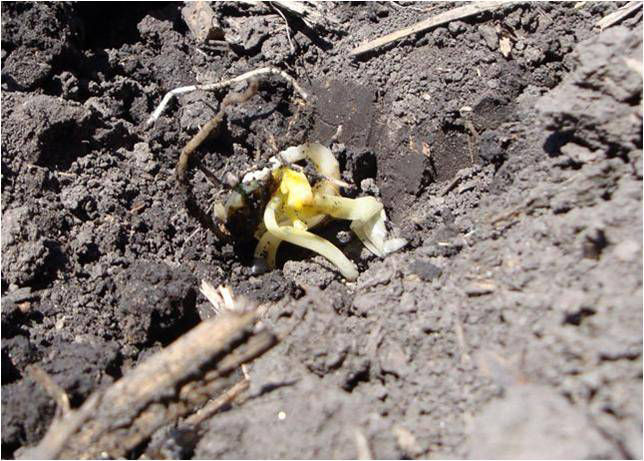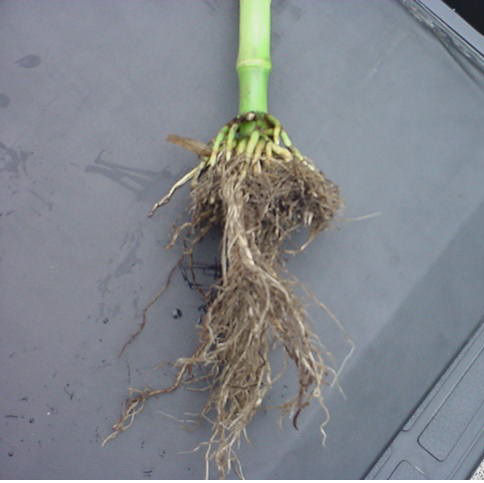10 MIN READ
Considerations for Corn Stand Establishment
March 7, 2021
What role does soil temperature and condition play before and after corn is planted?
Establishing the desired corn stand begins with planting into a seed bed that is well prepared, has adequate moisture, and soil temperatures in the seed zone are near and holding around 50°F. Seed beds that are cloddy or have uneven residue levels from the previous crop can prevent good seed to soil contact and can have varying temperature levels within the seed zone.1 Soil moisture in most years is adequate for germination; however, it may not be at a consistent level in the upper soil profile; therefore, planting depth can be critical to ensure that all the seeds have adequate moisture for germination and early consistent growth across the stand. Earlier planting dates are typically not at the required temperature of 50°F for germination. However, it is recommended to plant corn when the soil temperature within the seed zone is anticipated to be at 50°F soon after planting.
What are potential problems associated with planting corn when soil temperatures are below 50°F and remain so for an extended period?
When a corn seed is placed in the seed zone, it almost immediately begins to imbibe water and will absorb about 30% of its weight in water to start the germination process.2 Under some situations when the water is extremely cold and imbibed it can result in death of the kernel or developing embryo. This is often referred to as cold shock. Cold shocked seeds will be swollen, yet very hard, and in some cases the coleoptile will have emerged. If the seed is killed by a fungal pathogen, it will usually be soft and easily collapsed. The other type of injury that can occur under cold temperatures, is referred to as chilling injury (Figure 1). Chilling injury occurs after the seed has germinated and the mesocotyl has emerged.3 Cold temperature can kill cells on one side of the mesocotyl and not the other. Mesocotyl cells are rapidly elongating and the cells on the opposite side from the injury continue to grow causing the mesocotyl to cork-screw. Other factors, like herbicide carryover or soil crusting may cause this type of injury as well.

Figure 1. Corn seedling damage by chilling injury.
Can the type of tillage used impact a corn stand?
Tillage means land is tilled and it helps to mechanically reduce weeds, loosen soil which helps in aeration and facilitates the uniform crop planting, and it also help mixing crop residue in soil. Tillage operations are evolved over the time to fulfill the specific production requirements of crop. Some farmers do not use a single tillage type for all farming operations. Instead, a different kind of tillage types are deployed to meet the productivity of specific land and crop.
Conventional tillage attempts to cover most of the residue, leaving less than 30% of the soil surface covered with residue after planting. Soils can warm faster when crop residue is incorporated, which can aid in emergence especially for early-planted fields.4
Strip tillage tills a 7-inch band in the planting zone while no-till planters are equipped with row cleaners to remove residue from the planting zone.5 Soils that are poorly drained or have large amounts of residue can delay soil warming and drying in early spring. This condition is less of a concern for normal planting dates.
Fields are at capacity - should I be concerned with compaction?
Yes. Soil compaction occurs as the result of working soils or driving on soils under wet conditions, or when water displaces air pore space in the soil. Water can act as a lubricant between soil aggregates, forcing them to become tightly packed together. Soil compaction can lead to poor root development and limited nutrient and water availability.
Sidewall compaction can occur in the seed furrow if the soil contains too much moisture at planting (Figure 2). This can prevent the primary root or seed radical from penetrating through the compaction into surrounding soil and nutrients. Ultimately, the seedling may die or result in a “nonproductive” plant.

Figure 2. Limited root growth due to sidewall compaction.
Fields are at capacity - should I be concerned with compaction?
Yes. Soil compaction occurs as the result of working soils or driving on soils under wet conditions, or when water displaces air pore space in the soil. Water can act as a lubricant between soil aggregates, forcing them to become tightly packed together. Soil compaction can lead to poor root development and limited nutrient and water availability.
Sidewall compaction can occur in the seed furrow if the soil contains too much moisture at planting (Figure 2). This can prevent the primary root or seed radical from penetrating through the compaction into surrounding soil and nutrients. Ultimately, the seedling may die or result in a “nonproductive” plant.
What are starter fertilizers and how can they be useful for crop establishment?
The most common recommended placement for starter fertilizer is 2 inches to the side and 2 inches below the kernel at planting. This placement reduces seed injury, especially under dry soil conditions in light or sandy soils.6 Starter fertilizers may help mitigate decreased mineralization and reduced nutrient mobility found in cool, wet soils typical during planting. Starter fertilizers can help establish a uniform stand that may pollinate earlier and have a higher tolerance to heat stress.7
I planted after applying anhydrous ammonia in the spring. Can this stress the emerging corn?
It depends. Planting too quickly after an anhydrous ammonia application could result in root burn. General recommendations are to wait approximately 7 to 10 days to plant after an anhydrous ammonia application.8 However, there is no definitive waiting period as injury to spring-planted seedlings has occurred from fall-applied anhydrous ammonia. Anhydrous applications should be applied diagonally across the field to avoid the potential of placing a corn row directly into a previous anhydrous ammonia knife slot.9 For more information, please read this article Anhydrous Ammonia Injury to Corn.
Can planting conditions affect the seeding rate?
Yes. The seeding rate should be adjusted according to the planting conditions. Early and late planted corn may require a higher seeding rate for the same final plant population than corn planted under ideal conditions. For example, late-planted corn with 90% emergence and a desired final crop stand of 30,000 plants per acres will require a seeding rate of 33,300 seeds per acre (30,000/.90).10 Seeding rate calculators are available to help provide regional recommendations based on historic yields.
How can planting depth and speed affect corn stand establishment?
Seeds should be planted at a consistent depth into adequate moisture and with good seed-to-soil contact to help establish uniform emergence.11 Normally, the planting depth should be 1.5 to 2 inches. A depth of less than one inch may result in the nodal root system developing too close to the soil surface, which can lead to rootless corn syndrome. Birds and other animals are more likely to feed on shallow-planted seeds. Planting depth and spacing should be checked regularly during planting to ensure proper placement.
Plant spacing uniformity and accuracy may be improved by adjusting the planter speed.12 In a study completed by the University of Nebraska, seed spacing accuracy was reduced as planting speed was increased.13
What measures should be taken for weed control?
Successful weed control is very crucial for economical corn production. Weeds compete for moisture, nutrients, and light during the growing season and interfere with corn stand establishment and with harvest which can eventually reduce yield potential. Good weed control management practices are required in all phases of corn production.14
Its’s ideal to control the existing weeds before planting by implementing preplant tillage operations, herbicides, or a combination of tactics for the crop to establish under weed-free conditions. However, as weeds become larger the effectiveness of tillage to control weeds before planting can be reduced. The risk of crop stand establishment issues and yield loss increases if the crop emerges in a dense stand of large weeds. Before enacting any plan for weed control, field scouting is very important to determine weed species and weed density.
What measures should be taken to keep pest pressure under control?
Soil insects such as wireworm, seedcorn maggot (Figure 3), white grub, and grape colaspis can feed on seed kernels and destroy germinating seeds. Seed treatment products can help provide protection against these and other labeled soil insects, as well as seedling diseases including Fusarium, Rhizoctonia, and Pythium. Protection may be enhanced with additional premium seed treatment products to further help protect seed from black cutworm and corn nematode pressure after root development initiation. For more information, please read the article, Managing Seed and Seedling Insect Pests in Corn.
Sources
1 Thomison, P. R. 2016. Assessing effects of uneven emergence on corn yields. Ohio State University Extension. https://ohioline.osu.edu/factsheet/agf-122
2 Nielsen, R.L. 2000. Corn growth and development. What goes on from planting to harvest?
Purdue University. https://www.agry.purdue.edu/
3 Elmore, R. 2012. Imbibitional chilling and variable emergence. Iowa State University. Integrated Crop Management News. https://crops.extension.iastate.edu/cropnews/2012/05/imbibitional-chilling-and-variable-emergence
4 Lauer, J. 2014. Corn Tillage Systems. Corn Agronomy. University of Wisconsin-Madison.
http://corn.agronomy.wisc.edu/Management/L007.aspx
5 Licht, M. 2019. Considerations for continuous corn. Iowa State University. https://crops.extension.iastate.edu/cropnews/2019/11/considerations-continuous-corn
6 Beegle, D.B., Roth, G.W., and Lingenfelter, D.D. 2007. Starter fertilizer. Penn State Extension.
Agronomy Facts 51. https://extension.psu.edu/
7 Hergert, G. W., C. S. Wortmann, R. B. Ferguson, C. A. Shapiro, and T. M. Shaver. 2012. Using starter fertilizers for corn, grain sorghum, and soybeans. G361 University of Nebraska-Lincoln. https://extensionpublications.unl.edu/assets/pdf/g361.pdf
8 Schwab, G. 2009. Avoiding anhydrous ammonia seedling injury. Corn & Soybean News.
Volume 9, Issue 4. University of Kentucky. http://www.uky.edu/Ag/CornSoy/cornsoy9_4.htm#3
9 Sawyer, J.E. 2009. Corn seedling damage from Ammonia. Integrated Crop Management. Iowa State University. IC-490(12). https://crops.extension.iastate.edu/cropnews/2009/06/corn-seedling-damage-ammonia
10 Costa, R. 2019. Late planted corn: should I change my seedling rates? Michigan State University. https://www.canr.msu.edu/news/late-planted-corn-should-i-change-my-seeding-rates
11 Coulter, J. 2019. Key factors for evaluating corn stand establishment. University of Minnesota Extension. https://blog-crop-news.extension.umn.edu/2019/05/key-factors-for-evaluating-corn-stand.html
12 Elmore, R. 2002. How does planter speed affect plant spacing? Iowa State University. Corn
Production. https://crops.extension.iastate.edu/encyclopedia/planter-speed-affect-plant-spacing
13 Jasa, P. 2007. Increased planting speed can cost yields. Nebraska crop production & pest management information. University of Nebraska. Crop Watch. https://cropwatch.unl.edu/increased-planting-speed-can-cost-yields
14 Ferrell, J. A., G. E. MacDonald, and P. Devota. 2020. Weed management in corn. #SS-AGR-02. University of Florida IFAS extension. https://edis.ifas.ufl.edu
Web sources verified 1/15/21. 3013_Q2